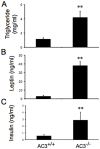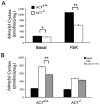Adult type 3 adenylyl cyclase-deficient mice are obese
- PMID: 19750222
- PMCID: PMC2735775
- DOI: 10.1371/journal.pone.0006979
Adult type 3 adenylyl cyclase-deficient mice are obese
Abstract
Background: A recent study of obesity in Swedish men found that polymorphisms in the type 3 adenylyl cyclase (AC3) are associated with obesity, suggesting the interesting possibility that AC3 may play a role in weight control. Therefore, we examined the weight of AC3 mice over an extended period of time.
Methodology/principal findings: We discovered that AC3(-/-) mice become obese as they age. Adult male AC3(-/-) mice are about 40% heavier than wild type male mice while female AC3(-/-) are 70% heavier. The additional weight of AC3(-/-) mice is due to increased fat mass and larger adipocytes. Before the onset of obesity, young AC3(-/-) mice exhibit reduced physical activity, increased food consumption, and leptin insensitivity. Surprisingly, the obesity of AC3(-/-) mice is not due to a loss of AC3 from white adipose and a decrease in lipolysis.
Conclusions/significance: We conclude that mice lacking AC3 exhibit obesity that is apparently caused by low locomotor activity, hyperphagia, and leptin insensitivity. The presence of AC3 in primary cilia of neurons of the hypothalamus suggests that cAMP signals generated by AC3 in the hypothalamus may play a critical role in regulation of body weight.
Conflict of interest statement
Figures









References
-
- Kopelman PG. Obesity as a medical problem. Nature. 2000;404:635–643. - PubMed
-
- Bray GA. Obesity: The disease. J Med Chem. 2006;49:4001–4007. - PubMed
-
- Fontaine KR, Redden DT, Wang C, Westfall AO, Allison DB. Years of life lost due to obesity. JAMA. 2003;289:187–193. - PubMed
-
- Spiegelman BM, Flier JS. Obesity and the regulation of energy balance. Cell. 2001;104:531–543. - PubMed
-
- Fontaine KR, Barofsky I. Obesity and health-related quality of life. Obes Rev. 2001;2:173–182. - PubMed
Publication types
MeSH terms
Substances
Grants and funding
LinkOut - more resources
Full Text Sources
Medical
Molecular Biology Databases

